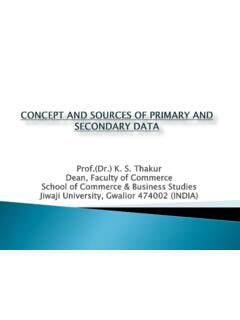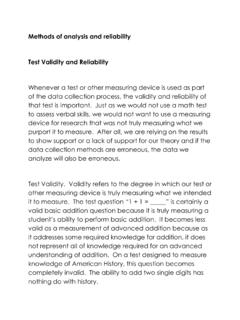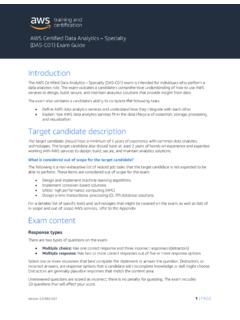Transcription of Data Collection and Incident Analysis Methods
1 6 data Collection andIncident Analysis INTRODUCTIONThe preceding chapters of this book have focused on how accidents due tohuman error can be prevented at source. These preventive measures includesystematic design strategies, techniques to identify potential errors with seri-ous consequences, and audits of performance-influencing factors in existingsystems to specify opportunities for improvements. To complement theseproactive strategies, it is important to have feedback systems in place so thatlessons can be learnt effectively from minor incidents, near-misses and frommajor accident investigations. This chapter describes a range of techniques andsystems to achieve these most plant managers, the term data Collection , at least in the context ofsafety, refers to the Collection of statistical data in areas such as lost-timeaccidents and other reportable injuries.
2 Because such data are required by law,and because they are perceived to have a major impact on accident preventionvia their motivational effects, considerable resources are expended every yearto produce these data . They constitute the "bottom line" that will be used tojustify the safety performance of the organization to the public, the regulators,and to its shareholders. Although the central importance of this aspect of datacollection is acknowledged, this chapter will describe a much wider range ofdata Collection activities that need to be carried out in order to maximize theeffectiveness of error reduction programs in publication produced by the Center for Chemical Process Safety,Guidelines for Investigating Chemical Process Incidents (CCPS, 1992d), is directedat achieving similar objectives but from a differing perspective and withdiffering emphasis.
3 Both sources of information can be used in a complemen-tary manner to improve the quality of data Collection and Incident Analysis inthe chapter is divided into the following sections:Overview of data Collection Systems ( )This section provides an overall structure within which the different aspectsof data Collection and Incident Analysis Methods can be integrated. The impor-tance of effective data Collection systems as part of the continuous improve-ment process in Total Quality of data Collection System ( )The major categories of data Collection systems are described. These include: Incident reporting systems, designed to identify underlying and directcauses for larger numbers of incidents with relatively minor causes Near-miss reporting systems Root cause Analysis systems, intended to provide in-depth evaluations ofmajor incidents Quantitative human reliability data Collection systems for generating hu-man error probabilities for use in quantitative risk and Cultural Aspects of data Collection ( )This section discusses the company culture that is necessary to supporteffective data Collection and root cause of data Collected ( )
4 The types of data required for Incident reporting and root cause analysissystems are specified. data Collection practices in the CPI are described, anda detailed specification of the types of information needed for causal analysesis of data Collection , Storage, and Retrieval ( )This section provides information on the personnel who should be involvedin data Collection and the design of reporting forms. The specific data needsfor major Incident analyses are discussed, together with the storage andretrieval of data for the purpose of Interpretation ( )The need for a causal model to guide data Collection is emphasized.
5 This makesthe connection between the nature of the error and the PIFs in the Cause Analysis Techniques ( )A range of techniques is described for analyzing the structure of incidents andthe causal factors and Monitoring the Effectiveness of Error Reduction Measures ( )The specification and implementation of error reduction measures arisesdirectly from the identification of causes. The data Collection system needs tobe able to evaluate the effectiveness of such up a data Collection System in a Chemical Plant ( )This section sets out a step-by-step procedure for setting up a data collectionsystem, including the important issues of gaining workforce acceptance andmanagement AN OVERVIEW OF data Collection SYSTEMSThe function of this section is to provide an overall framework within whichto describe the important aspects of data Collection systems in the CPI.
6 Asmentioned in the introduction, the emphasis in this chapter will be on methodsfor identifying the causes of errors that have led to accidents or significant nearmisses. This information is used to prevent reoccurrence of similar accidents,and to identify the underlying causes that may give rise to new types ofaccidents in the future. data Collection thus has a proactive accident preven-tion function, even though it is retrospective in the sense that it is usuallycarried out after an accident or near miss has already an overall proactive error management system, data Collection providesfeedback information on the effectiveness of specific interventions that havebeen made to reduce error potential.
7 However, in most plants in the CPI suchproactive error management strategies will not be in existence. Therefore, thesetting up of a data Collection system which addresses human error causes willoften be the first stage of an error management program. The advantages of thisare twofold. First, both company and regulatory requirements mean that someform of data Collection system, even if it only fulfills the most basic of statutoryrequirements, will probably already be in existence. It is therefore possible tobuild upon this to develop a more comprehensive system designed to addressthe underlying causes of incidents. Setting up a data Collection system as thefirst stage of an error management program provides insights into where themajor problems lie, and hence allows subsequent proactive interventions to betargeted at the areas where the most rapid benefits will be provides an overview of the structure of a data collectionsystem.
8 As with all aspects of human error management, the attitudes andbeliefs held by the company and plant management to safety in general, andhuman factors in particular, will be critical in developing a successful datacollection system. Management will influence the effectiveness of data collec-tion systems in three ways. First, they control the resources required to set upand maintain the system. Second, management will be responsible for deter-mining the culture that exists in the plant. As will be discussed in more detailin Section , if management encourages a culture which emphasizes blameand punishment for errors, then it is unlikely that a data Collection systemwhich is intended to address the underlying causes of incidents will ever besuccessful.
9 Third, the attitudes of management will determine the "model" ofCOMPANYAND PLANTMANAGEMENTATTITUDESTO ERRORDATACOLLECTIONSYSTEMCHARACTERISTICS TYPES OF DATACOLLECTEDMETHOD OF Collection ,STORAGE AND PROCESSINGINTERPRETATIONGENERATION OF GENERICAND SPECIFIC ERRORREDUCTION STRATEGIESIMPLEMENTATIONEFFECTIVENESSMON ITORINGFEEDBACKCONTINUOUSIMPROVEMENT SAFETY ENVIRONMENTALIMPACT PLANTLOSSESREGULATORSSHAREHOLDERSGENERAL PUBLICFIGURE Overall Structure of data Collection SystemMODEL OFHUMAN ERRORCAUSATIONPLANTCULTURETECHNICALMETHO DSWORKFORCEACCEPTANCEAND SUPPORT error causation that drives the data Collection effort. Thus, the traditional viewof human error which emphasizes individual rather than system causes oferror (see Chapter 2) will lead to the use of data Collection and analysismethods which focus on these factors.
10 The use of the systems view will meanthat there will be greater emphasis on the systemic causes of errors such aspoor procedures, equipment design or model of human error held by management and the plant cultureconstitutes the environment in which the data Collection system this environment, all data Collection systems need to address the topicslisted in Figure These topics, from the types of data collected, to thefeedback systems that need to be in place, will be addressed in subsequentsections of this emphasizes the fact that the outputs from data collectionsystems, particularly those that address safety and environmental issues, areof critical importance to an organization in that they are used as majorindications of the acceptability of a company's operating practices by regula-tors, shareholders, and the general public.










